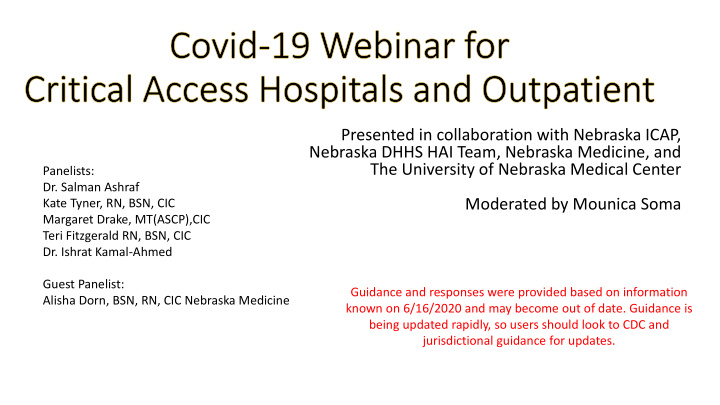



Presented in collaboration with Nebraska ICAP, Nebraska DHHS HAI Team, Nebraska Medicine, and The University of Nebraska Medical Center Panelists: Dr. Salman Ashraf Moderated by Mounica Soma Kate Tyner, RN, BSN, CIC Margaret Drake, MT(ASCP),CIC Teri Fitzgerald RN, BSN, CIC Dr. Ishrat Kamal-Ahmed Guest Panelist: Guidance and responses were provided based on information Alisha Dorn, BSN, RN, CIC Nebraska Medicine known on 6/16/2020 and may become out of date. Guidance is being updated rapidly, so users should look to CDC and jurisdictional guidance for updates.
Basic CDC Guidance on Re-opening Still Holds Before expanding to provide elective services, healthcare systems must operate without crisis standards of care. • Ensure adequate • HCP staffing • bed capacity • availability of personal protective equipment and other supplies https://www.cdc.gov/coronavirus/2019-ncov/hcp/framework-non-COVID-care.html
Importance of local COVID-19 transmission data • Substantial community transmission : Large-scale community transmission, including within communal settings (e.g., schools, workplaces) • Minimal to moderate community transmission : Sustained transmission with high likelihood or confirmed exposure within communal settings and potential for rapid increase in cases • No to minimal community transmission : Evidence of isolated cases or limited community transmission, case investigations underway; no evidence of exposure in large communal setting
From broad guidance to the local level • Joint Statement: Roadmap for Resuming Elective Surgery after COVID- 19 Pandemic “Facilities should use available testing to protect staff and patient safety whenever possible and should implement a policy addressing requirements and frequency for patient and staff testing .” https://www.aorn.org/guidelines/aorn-support/roadmap-for-resuming-elective-surgery-after-covid-19
Non-operative and Ambulatory Pre-Procedure Testing for COVID-19 Testing is not mandatory for procedures in which the risk of airway compromise is considered low (local anesthetic, mild sedation or select moderate sedation cases) IF: • Patients who are asymptomatic and can wear a procedure mask at all times • Patients who are asymptomatic and mask cannot be worn for a short period (<15 minutes) during the procedure but all staff wear procedure masks https://www.nebraskamed.com/sites/default/files/documents/covid-19/procedural-guidance-for-low-risk- procedures05112020.pdf
Non-operative and Ambulatory Pre-Procedure Testing for COVID-19 Non-operative and Ambulatory Pre-Procedure Testing Guidance • High-risk aerosol-generating procedures(AGPs) are defined within the perioperative guidance and include • surgery anywhere within the upper respiratory tract • flexible bronchoscopy • Rhinoscopy • laryngoscopy (including intubation) • GI endoscopy procedures with need for sedation or spinal anesthetic that have a high likelihood of requiring manual (bag valve mask) ventilation or intubation ( such as TEE, ECT, cardioversion, C-section) • ENT/OMFS/Dental procedures utilizing cautery, laser, drill or saw within the airway or oral cavity. https://www.nebraskamed.com/sites/default/files/documents/covid-19/procedural-guidance-for-low-risk- procedures05112020.pdf
When COVID-19 Testing for patients should be done: • COVID19 pre-procedural testing is mandatory for elective procedures requiring deep sedation/analgesia and anesthesia. • Patient has any symptoms concerning for COVID19; Symptomatic patients must be evaluated, and procedures should be deferred until acute illness has resolved (per other guidance). If COVID19+, will need to defer procedure if possible. If urgent, COVID19 level precautions should be taken. • In cases where Infection Control has approved specific guidance unique to a specialty, such as Dentistry, Interventional Radiology, ECT* https://www.nebraskamed.com/sites/default/files/documents/covid-19/procedural-guidance-for-low-risk- procedures05112020.pdf
Perioperative Testing Guidance • Complex and multi-factorial • Advise looking at all of the resources: https://www.nebraskamed.com/for-providers/covid19/operating- room-procedures
- https://www.nebraskamed.com/sites/default/files/documents/covid-19/preprocedural-testing-algorithm-for-covid- positive-patients.pdf
Pre-procedure testing AORN https://www.aorn.org/guidelines/aorn-support/roadmap-for- resuming-elective-surgery-after-covid-19 Facilities should use available testing to protect staff and patient safety whenever possible CHI https://www.chihealth.com/en/patients-visitors/coronavirus-covid- 19/covid-19-elective-surgery-precautions.html “Requiring COVID-19 testing for patients prior to certain procedures to provide appropriate care and to reduce the risk of infection for caregivers .”
Frequently Asked Questions
Image: Pixabay Should we see nursing home patients in our clinics? Aren’t they really high risk for bringing COVID-19 into the facility ?
Yes! • Long-term care facilities have had stringent infection control processes since March. • Recommend use of a procedure mask for the resident: • Plus procedure mask for HCW for non-COVID-19 visits • Plus N95 respirator, gown, gloves, eye protection for COVID-19 visits
Is there a tool to help me plan for or quantify a potential surge in COVID-19 cases? Image: Pixabay
Yes! Here is a CDC tool for calculating a surge in your community https://www.cdc.gov/coronavirus/2019-ncov/hcp/COVIDSurge.html [cdc.gov]
It has been a month since our Do we really need to keep resident was tested positive and he is 6 feet of distance between still testing positive although asymptomatic for a week now. How our coworkers in the break long we should keep testing. room? Image: Pixabay
Yes! • Maintain at least 6 feet distance from others, especially when mask use is not feasible (such as during eating or drinking) • Decrease the number of employees in break areas • Eat in shifts • Go outside to eat • Open up additional space for breaks https://www.cdc.gov/coronavirus/2019-ncov/community/guidance-business-response.html for additional tips
IP Office Hours Monday – Friday 7:30 AM – 9:30 AM Central Time 2:00 PM -4:00 PM Central Time Call 402-552-2881
Questions and Answer Session Use the QA box in the webinar platform to type a question. Questions will be read aloud by the moderator If your question is not answered during the webinar, please either e-mail it to NE ICAP or call during our office hours to speak with one of our IPs A transcript of the discussion will be made available on the ICAP website https://icap.nebraskamed.com/coronavirus/ https://icap.nebraskamed.com/covid-19-webinars/ Panelists today are: Dr. Salman Ashraf salman.ashraf@unmc.edu Kate Tyner, RN, BSN, CIC ltyner@nebraskamed.com Margaret Drake, MT(ASCP),CIC Margaret.Drake@Nebraska.gov Teri Fitzgerald RN, BSN, CIC tfitzgerald@nebraskamed.com Dr. Ishrat Kamal-Ahmed Ishrat.Kamal-Ahmed@nebraska.gov Alisha Dorn, BSN, RN, CIC adorn@nebraskamed.com
Questions and Answer Session Use the QA box in the webinar platform to type a question. Questions will be read aloud by the moderator, in the order they are received A transcript of the discussion will be made available on the ICAP website Moderated by Mounica Soma, MHA https://icap.nebraskamed.com/resources /
Recommend
More recommend